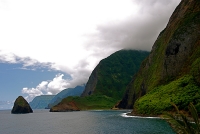
The tiny Hawaiian island of Molokai has been called the 'island that the world has left behind'. It is largely untouched by tourism and development, there are no highrise buildings, traffic lights or fast food outlets, even in the main town of Kaunakakai.
As small as it is (you can drive from tip to tip in a couple of hours) this authentic paradise boasts Hawaii's longest white sand beach and other black sand stretches; the only barrier reef north of Australia; a lowland desert, some rainforests and ancient Hawaiian heiau (temples). The island was once a place of refuge for those who violated the Hawaiian kapu (taboo) system, and many visitors are drawn by the mana (spiritual power) that still seems to infuse this naturally beautiful spot.
East of the Kalaupapa peninsula, to the north of the island, is the world's highest sea cliff, Kahiwa Falls. The peninsula itself used to be a leper colony in the mid-19th century, and some sufferers of the ailment continue to live there out of choice. Molokai's main claim to fame, however, is as the place where the famous Hawaiian hula dance was born. Each May a hula festival is held in Papohaku Beach Park in honour of the dance.

Travel Guide powered by Word Travels, copyright © 2023 Globe Media Ltd. By its very nature information in this travel guide is subject to change at short notice and travellers are urged to verify information on which they're relying with the relevant authorities. Neither Globe Media Ltd nor Travel Vogue can accept any responsibility for any loss or inconvenience to any person as a result of information contained above.